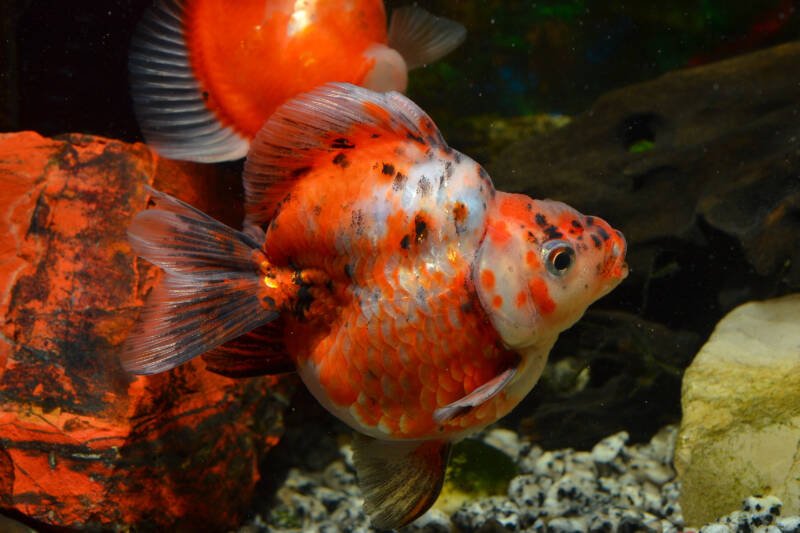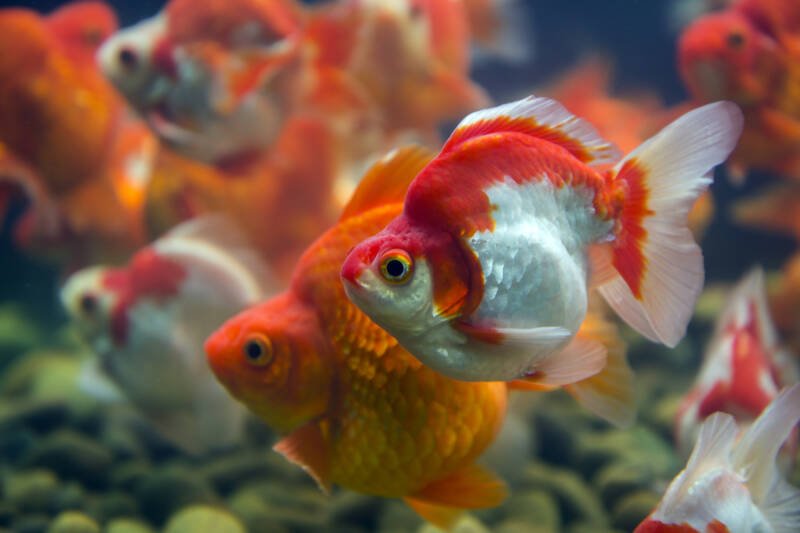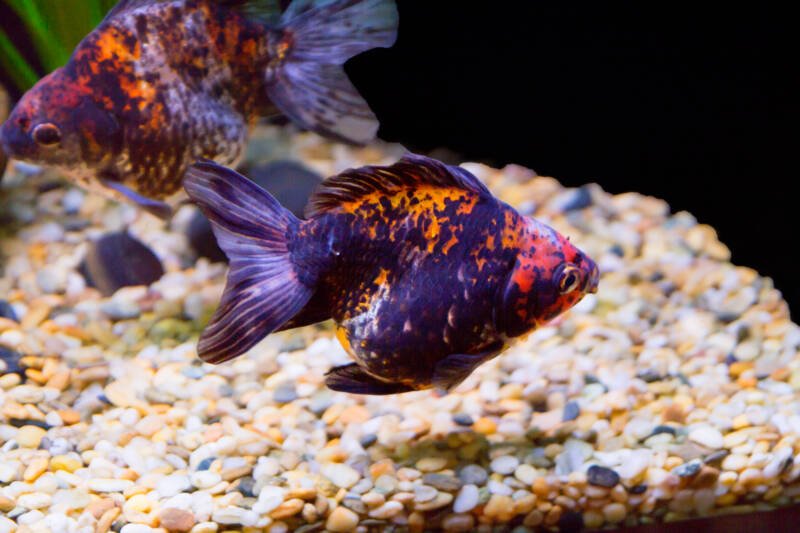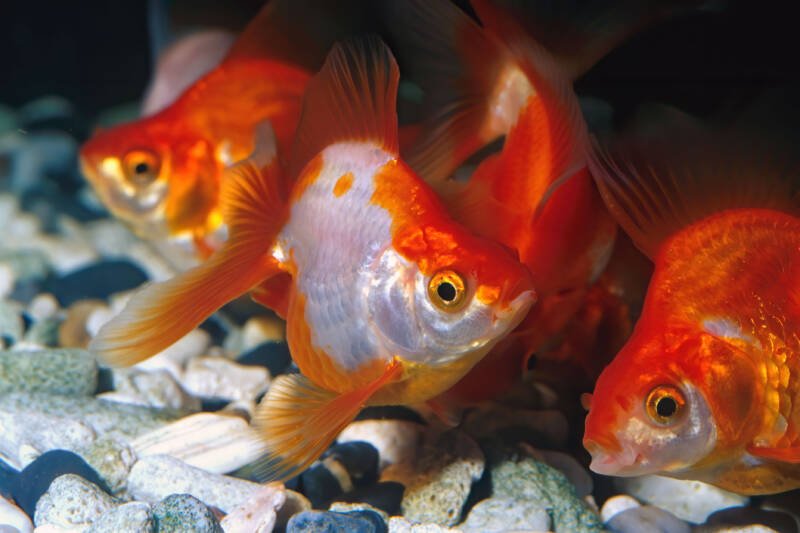The Ryukin goldfish (Carassius auratus) holds a place as one of the most popular varieties out there when it comes to fancy goldfish.
Not only do they have a dramatic appearance, but they also stand out with an active lifestyle – and a bit of a gruff personality.
Similar to fantails, Ryukins have the double caudal fins you find in fancy goldfish. But that’s where similarities end.

Ryukin goldfish have a dorsal hump that extends up from the neck, providing a narrow, pointed head to their silhouette.
And if you compare the tails of both fish side-by-side, fantails come out with a narrower profile.
That goes for both the short-finned and long-finned Ryukins. Once you know what to look for, the two varieties are easy to tell apart.
Ryukins achieved their popularity with aquarists through their looks and ease of care.
Provided you can manage high water quality, they don’t have a long list of demands. They’re sturdy, despite falling in the “fancy” group.
At a Glance
- Tank Size: 20 gallons (76 l)
- School Size: can get housed alone; better in a school of at least 4
- Lifespan: 10-15 years
- Size: 6-8 inches (15-20 cm)
- Temperature: 64-72F (18-22C)
- pH: 6.5-8.0
- Hardness: 5-19 dH
- Ammonia: 0 ppm
- Nitrite: 0 ppm
- Nitrate: 0 ppm
In this article
In the “Wild”
While the official origins of the Ryukin goldfish are uncertain, most people believe they got their start in China.
In the late 1700s, they started appearing in the Ryukyu Islands.
The islands form a chain between Taiwan and the mainland of Japan – and gave the fish its name.
People started writing about these egg-shaped goldfish throughout the 18th and 19th centuries.
And while that sounds impressive, it’s late compared with other fancy goldfish varieties.
They’re “undeveloped” when placed against moors, orandas, and ranchus.
Of course, they share a similar rounded profile with many of those varieties.
And coming late to the party? It means they aren’t as inbred and over-utilized in genetic lines as some of their cousins.
This allows them a hardier nature and a quicker swimming speed.
As they moved through the Ryukyu chain, aquarists developed new color patterns.
Now you’ll find Ryukins in red, white, chocolate, or their most famous pattern: a tricolor of orange, white, and black.
The tricolor gives them their other name, the calico goldfish.
Size: Quick to Fill the Space
Ryukin goldfish have a rapid growth rate, even for the goldfish species.
You can see them exceed the standard inch (2.5 cm) per year.
However, you’ll still see variations based on their environment, the quality of their food, and their health.
Most Ryukins end up somewhere around 6-8 inches (15-20 cm) at final length.
If you choose to keep your goldfish outside in a pond, however, you may see your fish grow to an astounding 10 inches (25 cm).
As goldfish, they DO grow to fit the size of their home.
Lifespan
Due to the hardy nature of their “newness,” Ryukins don’t struggle with as many health problems as other fancy goldfish.
And as long as you provide the best living situation for them, you should see a lifespan of anywhere from 10-15 years.
Of course, the bigger and better a space you provide, the higher your odds go of beating that average.
Plenty of aquarists that keep their Ryukins in ponds and larger tanks have seen their fish live for up to TWENTY years!
Behavior

Most of the fancy goldfish with egg-shaped bodies struggle to maneuver around the water column.
It makes them tricky to keep in outdoor ponds. Not to mention you need to have care for their management in community tanks.
But Ryukin goldfish break the mold. They’ve mastered their double tails and round shape, swimming actively in whatever housing you choose.
It makes them an ideal choice for aquarists looking for an aquarium with a little more movement.
Unfortunately, there’s a downside. Able to keep up with even common goldfish, Ryukins have developed a semi-aggressive streak.
They’ll bully slower fish around them. And if they think something smaller might make a tasty snack? They don’t hesitate to chase the fish down.
You can help temper some of that behavior by keeping your Ryukins in a school. They’ll tolerate staying on their own, but they respond better in a shoal of at least four. You’ll see more outgoing personalities, and the fish will focus on each other – rather than on who they can pick on.
Tank or Pond Setup

As with any goldfish, Ryukins will grow to fit the space they’re kept in.
Technically, that means alone Ryukin goldfish can exist in a 10-gallon (38 l) tank.
But, in reality, that’s much too small. Your fish will end up crowded, and you’ll have trouble keeping wastes under control.
A minimum of 20 gallons (76 l) is your best bet. That will even allow you to keep a school without too much trouble.
Of course, if you want to provide a top-notch environment, you can always spring for an outdoor pond.
Ryukin goldfish belong to the cold water group of fish.
This means they’ll tolerate most outdoor air temperatures without a problem.
During the winter, they hibernate when the pond freezes. A pond provides them with the most room and a better chance to thrive.
You WILL need to make sure you have enough oxygen – whether you choose a tank or pond.
Ryukins require waters with a high level of dissolved oxygen. Air stones will do a better job than struggling with enough live plants (as we’ll touch on in a moment).
And while you have flexibility with your water temperatures, invest in a quality thermometer.
You’re going to need it to make sure you’re not getting outside of the ranges accepted by Ryukins.
If you don’t know what the water’s at, you can’t make corrections.
Water Conditions

You can keep Ryukin goldfish in outdoor ponds with relatively little trouble.
But you need to have that thermometer handy to make sure you stay within their range of 64-72F (18-22C).
You also need to ask where your Ryukins were raised.
Some stores keep their fish in tropical tanks. This doesn’t mean a pond is out of the question, but you WILL need to do some work.
A slow acclimatization process will prevent your fish from getting shocked.
If you’re in an area where ambient temperatures drop below that 64F/17.7C bottom threshold, you will need to get a tank heater.
Winter hibernation is one thing, but Ryukin goldfish can’t tolerate constant cold water. Again, check your thermometer carefully.
Otherwise, Ryukins are similar to other goldfish. They like their water as close to neutral as possible.
You CAN get away within that 6.0-8.0 pH range, though. And try to aim for a water hardness level of 5-19 dH.
Where they can differ is in their water quality.
Ryukins are sensitive to ANY kind of waste. That means ammonia, nitrate, and nitrite of 0 ppm.
You’ll need to make sure you have quality filters, perform necessary water changes, and stay on top of your cleaning schedules.
Decorating the Ryukin Tank or Pond
Ryukin goldfish like to rearrange décor – sort of like every other goldfish variety you might come across.
Unfortunately, while they’re actively excavating through the substrate, they aren’t thinking about their health and safety. You’ll need to do it for them.
Gravels and sands work best in your tank or pond.
If you choose gravel, pick one that’s a medium size with rounded edges.
This will protect your Ryukins’ heads and tails. The same goes for caves or artificial décor you may want to add.
Ryukin goldfish are HARD on live plants. They’ll nibble on the leaves, tear up roots, and make a mess of things.
Epiphytes – plants that attach anywhere – are your best bet if you don’t want to use plastic or silk plant options. And you have plenty of options:
Ryukin Goldfish in Communities

With their calico coloring, Ryukin goldfish make a colorful addition to any freshwater tank or pond setup.
You need to mind that semi-aggressive streak, but that doesn’t mean you can’t add them to a community.
Tank Mates
Typically, you can pair fancy goldfish varieties together without a problem.
But since Ryukins have a faster swimming speed, you’ll want to hold off on some of the slower fancies out there.
Instead, you can pick those who can defend themselves – and manage to compete for food.
It’s a pattern you should apply to ANY tank mate you decide to combine with Ryukin goldfish.
Remember, they can bully fish or chase after smaller species they might want to add to the menu.
Consider sticking to the following options:
- Barbs
- Black moor goldfish
- Danios
- Dojo loach
- Fantail goldfish
- Gouramis
- Lionhead goldfish
- Livebearers
- Oranda goldfish
- Ranchu goldfish
- Tetras.
Incompatible Species
While Ryukins can hold their own against their fancy cousins, they’re not as fast as larger, more aggressive fish.
You don’t want to put them in a position of becoming a snack themselves. While fast for a fancy goldfish, they’re still on the slow side of things.
You also need to watch out for particular algae eaters. These fish ADORE slime coats. And Ryukins can’t move fast enough to get out of the way.
Stripped of the protective mucus layer, your Ryukins can end up ill. That means avoiding all of the following tank mates:
- Bubble eye goldfish
- Celestial goldfish
- Chinese algae eater
- Cichlids
- Comet goldfish
- Plecostomus
- Red tail shark.
Food and Diet
Ryukin goldfish follow the expected pattern of ordering from the omnivore menu. And they’re not picky eaters.
However, their unique shape presents some digestive problems. If you’re not careful with your food choices, they could end up in trouble.
Ryukins have “dead zones” within their GI tracts. These are small pockets where food gets stuck, failing to get digested.
Gulping air at the surface when they inhale flakes or pellets makes things worse. The food remains trapped. As a result, the fish ends up constipated.
You can help by avoiding floating commercial foods. Even popular sinking pellets need some careful preparation.
You’ll need to soak them FIRST before adding them to the tank.
Otherwise, the food expands in the fish’s GI tract, leading to ANOTHER blockage.
But commercial foods shouldn’t be the only source of nutrition.
Ryukin goldfish have vibrant colors, and they need ready sources of protein (and vegetables) to keep those shades looking their best. Add in supplementation with live or frozen protein options:
- Bloodworms
- Brine shrimp
- Daphnia
- Earthworms.
And don’t forget the fruits and veggies! The green side of the menu is every bit as necessary.
Once you remove any skin and do a quick blanch to break down the outer cell wall, your Ryukins will happily devour any of the following:
- Apples
- Broccoli
- Lettuce
- Nori
- Oranges
- Peas.
Goldfish, in general, like to overeat. So you need to monitor mealtime carefully.
Because of their digestive problems, Ryukins should get several small meals a day.
This helps things move through their system better than a single large meal.
Breeding Ryukin Goldfish: A Number Game
If you want to breed your Ryukin goldfish, you should put together a school.
They ARE social, and you’ll end up with better results if you have a group.
A separate breeding tank of 20 gallons (76 l) will help you protect the eggs when the time comes.
Male or Female?
Ryukin goldfish look identical 99% of the time. It’s only during spawning season that you’ll start to notice differences.
And even then, signs get tricky to pick out. Sometimes the behavior is your best indicator of who’s who.
Before spawning, mature males develop breeding tubercles on their gill covers and foreheads.
The tiny white projections aren’t always a great indicator, though.
Immature males don’t produce as many of the projections. And even female Ryukins can pop up some tubercles!
Look for a male COVERED in the tubercles, to be sure. Better yet, watch for one that’s chasing around a rounder-than-usual fish.
The round one’s a female plump with eggs. And males start to chase (and get competitive) when they’re ready to breed.
Temperature Control
Breeding tanks don’t need a lot of decoration. A few leafy plants will do the trick.
Or, if you’d rather, you can use spawning mops. You want somewhere for the eggs to collect.
Start getting the tank (and your fish) ready several weeks before you plan to breed them.
Your first step is to separate your males and females.
Then you want to increase the amount of protein in their diets. Live and frozen foods work best. You’re triggering a response in their bodies with the extra protein.
As you start to see changes in their bodies, combine the sexes in the breeding tank and lower the temperature to 60F (15.5C).
Slowly increase that temp by 3 degrees each day while continuing your feeding regime.
Ryukin goldfish can lay up to 10,000 eggs. You’ll have no trouble seeing them in the leaves of your plants or the spawning mops.
As soon as you do, move the adults OUT of the tank. They’ll eat the eggs if you don’t. (No parental care, here!)
Ryukin eggs take around 4-7 days to hatch. You can use infusoria or powdered fish fry foods to feed them initially.
Once they’re large enough, switch them over to baby brine shrimp.
Ryukin fry grow FAST, so you’ll have no trouble moving them back to the tank or pond.
Hardiness and Diseases
Ryukin goldfish aren’t as delicate and prone to problems as some of the fancy goldfish.
But if you’re not careful about keeping up with their water conditions, you can start to see them change color to white or black. This means you have a SERIOUS problem!
And if you don’t manage a high-quality diet, broken up over multiple feedings, you can create more problems.
Remember, they don’t have the best digestive system.
Once they’re constipated, you need to address the issue. Peeled green peas work as a natural laxative.
Untreated, constipation can lead to problems with the fish’s swim bladder.
This can prompt issues with swimming or even cause your fish to flip upside down. As soon as you see the first signs of constipation, boil those peas. (And then address the diet)
Ryukin goldfish also have problems with fin rot and tail rot due to their long fins.
If you see any fraying or tears, you’ll want to seek treatment for the infection.
Tissue AWAY from the body can regenerate. But close to the body? You won’t see repairs. And untreated, it can lead to death.
Ryukin Goldfish: Are They For You?
Ryukin goldfish often fall on the pricey side for fancy goldfish. But it depends on where you purchase them and the variety you’re looking for.
The standard red or white colors come in at the low end of the spectrum, while the calico costs more.
And long-tails? They’re the rarest.
Ryukins found in pet stores or fish stores usually run anywhere between $8-$15 each.
But if you approach a well-known breeder, you may find yourself paying as much as $50 a fish. That can quickly get expensive if you’re planning to stock a pond!
Always make sure you take the time to examine any fish you plan to purchase.
You shouldn’t see any signs of fin rot. You also want an active fish eagerly exploring the housing tank.
Looking for these key features will help you protect your future pond investment.
Antique Calico Goldfish
Ryukin goldfish may not date back as far as some of the fancies, but they still made it into literature from the 18th century.
And with their unique shape and dynamic personality, they’re the perfect addition to any tank – or pond!
Do you keep Ryukins? Are they in a tank or outside in a pond?
What’s your setup for breeding?
Share your stories and questions with us here!